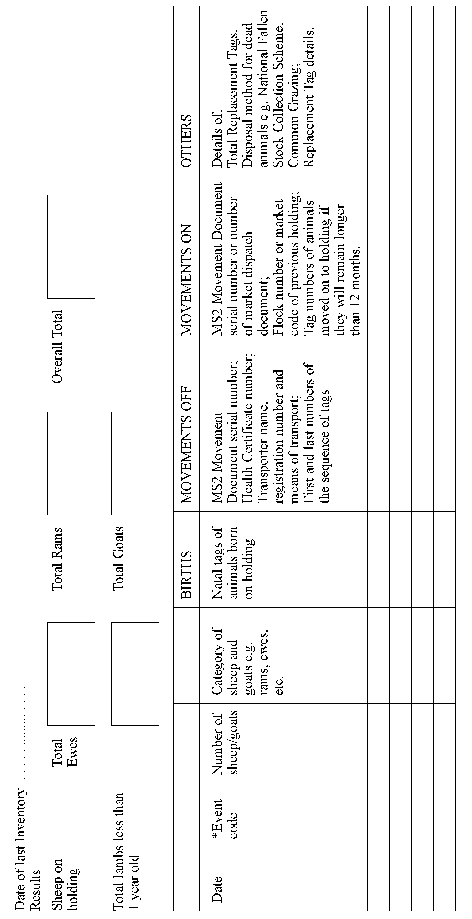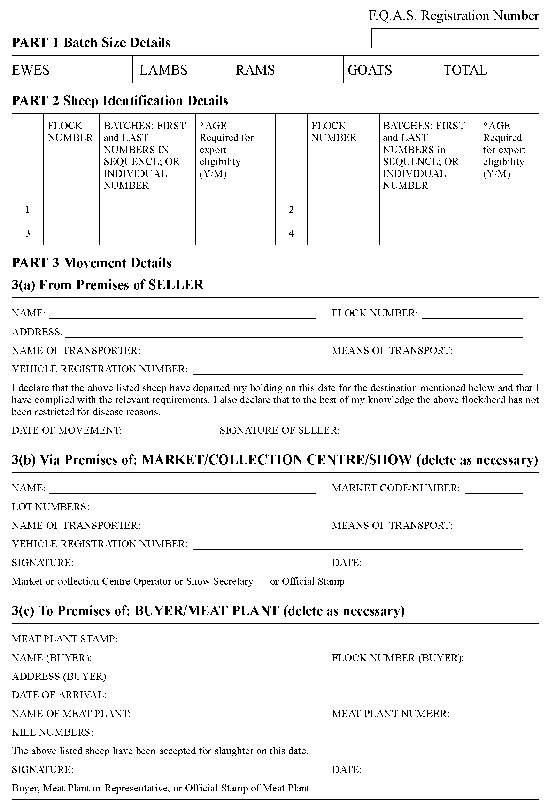Article 10
SCHEDULE 1SYSTEM REQUIRED BY SECTION A.5 OF THE ANNEX TO THE COUNCIL REGULATION
Animal movements
1.—(1) Where an animal is moved from its holding of birth (other than a market) to another holding in Northern Ireland it must be identified with a green approved eartag in its left ear (“the natal tag”).
(2) Where an animal which has previously been kept on a holding is moved to a second holding the keeper of that animal shall attach a further green approved eartag to the animal’s right ear within 12 months of residence on the second holding or before it leaves that holding, whichever is the earlier.
(3) Where an animal that is already marked with any 2 eartags applied under this Order or the Council Regulation is moved to any subsequent holding the keeper—
(a)shall record the flock number or herd number of the holding from which the animals were transferred; and
(b)shall not attach a further approved eartag to the animal except in accordance with Article 22(1) or with the permission of the Department.
(4) Where the keeper of an animal discovers that the characters on an eartag attached to an animal have become illegible or that an eartag has been lost he shall, within 24 hours after the discovery,—
(a)where an animal loses its natal tag on its holding of birth, replace the natal tag with an approved eartag bearing the next unused eartag number in the sequence allocated to that holding;
(b)where an animal has lost an eartag, other than a natal tag, replace it with a green approved eartag in accordance with paragraph (2);
(c)where an animal has lost all its eartags, attach an orange approved eartag to the left ear.
(5) A person shall not move an animal from a holding for consignment from Northern Ireland if it is marked with an—
(a)orange eartag applied under paragraph (4)(c) or under the Identification and Movement of Sheep and Goats Order (Northern Ireland) 2004; or
(b)eartag or tattoo with the letter “R” indicating that it is a replacement eartag or tattoo applied in accordance with equivalent legislation in Great Britain.
Export to Great Britain
2. An animal consigned for export to Great Britain shall be identified, tagged and accompanied by a movement document in accordance with—
(a)in the case of an animal born on or after 9th July 2005, the Council Regulation, including any derogation exercised under the Council Regulation; or
(b)in the case of an animal born on or before 8th July 2005, any of the previous Orders and any additional requirements imposed in legislation enforcing the Council Regulation.
Movement of animals from England, Scotland and Wales
3. When an animal is brought into Northern Ireland from a holding in England, Scotland or Wales, the keeper at the holding of destination must record the same information in the holding register as if the animal had been brought from a holding in Northern Ireland and “flock number” and “herd number” shall be construed as a flockmark or herdmark allocated by the competent authority in England, Scotland or Wales.
Common grazing
4.—(1) When an animal moves on to common grazing, the keeper shall—
(a)identify the animal in accordance with this Order before it is moved on to common grazing;
(b)only move the animal from the common grazing to—
(i)the holding of origin, or
(ii)a slaughterhouse either directly or, via a collection centre; and
(c)record the movement to or from the common grazing in his holding register.
(2) For the purpose of this paragraph, “common grazing” means land on which the keeper has a right of grazing in common with other proprietors.
Movement from dipping or shearing to the holding of origin
5. When an animal leaves a holding to which it was sent for dipping or shearing to return to the holding of origin, the keeper shall—
(a)identify the animal in accordance with this Order before it is moved for dipping or shearing;
(b)only move the animal from the holding to which it was sent for dipping or shearing directly to the holding that he brought it from or directly to slaughter; and
(c)record the move to or from the holding for dipping or shearing in his holding register.
Movement to and from a veterinary clinic
6.—(1) Where an animal is—
(a)moved off a holding to a veterinary clinic; and
(b)returned directly to that holding from the veterinary clinic
the keeper shall record the indicator “UK 9” and the number of the flock or herd from which the animal was moved in the holding register.
(2) The holding register shall be completed when the animal leaves the holding of origin and when it returns to that holding.
(3) When an animal arrives at, or is moved from, a veterinary clinic there are no requirements to complete the holding register or a movement document and no eartag identification requirements provided the animal is returned directly to its holding of origin.
Movement to an assembly centre
7.—(1) Where an animal is moved off a holding to an assembly centre, the keeper shall—
(a)record the individual animal identification number of that animal in the holding register; and
(b)complete Part 3(a) of the movement document.
(2) When the animal arrives at the assembly centre, the keeper at that centre shall record the identification number of the animal in the holding register at the assembly centre and shall endorse the movement document and return it to the Divisional Veterinary Office within 7 days of the animal’s arrival at the assembly centre.
Articles 15(2)(a) and 17(2)
SCHEDULE 2SHEEP AND GOATS (RECORDS, IDENTIFICATION AND MOVEMENT) ORDER (NORTHERN IRELAND) 2005
Article 18(2)


